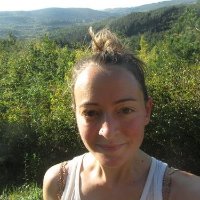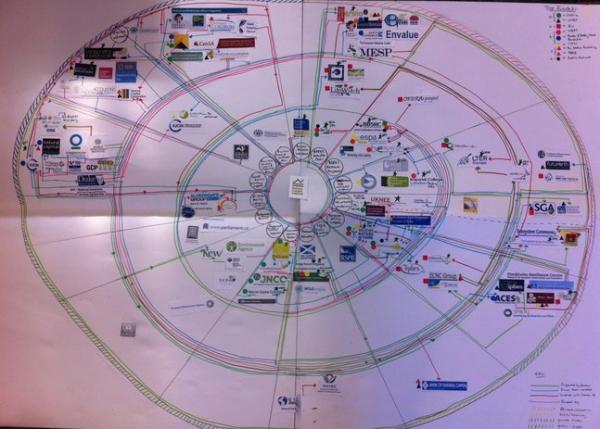 Irma Allen, NCI Development Officer, gets out her glue and scissors to map the fast-growing natural capital landscape:
Irma Allen, NCI Development Officer, gets out her glue and scissors to map the fast-growing natural capital landscape:
Since the NCI was established in 2009, the number of initiatives, projects, programmes, organisations, networks, coalitions (you name it), related to natural capital have proliferated seemingly exponentially – both internationally and across the sectors. This is testament to the traction which the natural capital concept has gained, as well as evidence of its ability to engage a broad audience. The NCI aims to act as a forum for bringing together these initiatives and others to exchange, collaborate, and find shared solutions.
To understand how NCI can best achieve this, I wanted to get an understanding of this new ‘natural capital landscape’ or organisational ecosystem. Where are people and projects connected? Where are there gaps? What types of activity are we all involved in and how we can work in a more connected way to maximise resources as well as impact? To start this process, largely through desk research, I ‘mapped’ initiatives around the world working in and around this space, attempting to visualise the relationships between them (using home-made cut-and-paste methods!): (Note of caution: Although NCI partners are scientists, this was not a scientific process, neither was it exhaustive.)

I identified 103 initiatives and grouped them across four sectors (the quarters of the ‘circle’ moving from clockwise from top-right): Research/academia; NGO/community; Public sector; and Private sector. These were spread across three geographical areas of focus (the rings moving outwards): UK, EU, and Global (largely the US or International bodies). 15 roughly-defined ‘types’ of initiative emerged, forming the segments (again, going clockwise from the top-right segment):
- Biodiversity & Ecosystem Services data/info/tools
- Biodiversity & Ecosystem Services Research Programmes
- Research Knowledge Exchange networks/platforms
- Practitioner Knowledge Exchange networks/platforms
- Research-policy interface
- NGO and public engagement
- Government valuation
- Government advisory body initiatives
- Government non-departmental bodies/agencies
- Parliamentary policy forums
- Cross-sector policy influencing platforms
- Government & business solutions support
- Business solutions support & leadership development
- Business tools & methods development
- Business-Research interface
The research highlighted that business-academic interaction on natural capital was less directly brokered, while public engagement on this area was very limited. It also highlighted that activity was largely concentrated in and emanating from the UK and the US, with funding coming mainly from organisations within the EU and the US. Out of 103 initiatives identified, the top five funders were found to be:
- Defra and UNEP (13 initiatives each)
- the EU (11)
- NERC, Gordon and Betty Moore Foundation, IUCN (6 each)
- The Nature Conservancy and TEEB (5 each)
- Scottish Government (4)
In addition to highlighting key funders, the same names of individuals involved kept cropping up. These ‘finger-in-many-pies’ people, the connectors, the idea-pollinators crossing these worlds, tended to move widely, but perhaps mainly staying within their own sphere – academia/research or business, primarily. Connecting these ‘champions’ across the sectors might itself prove a valuable activity, since they appear to be moving the agenda along in their own zone. Key busy movers and above-and-beneath-the-radar shakers include, but are not limited to (and in no particular order):
1) Our very own Prof. Rosie Hails who is involved at high level in not only in the Natural Capital Initiative, but also the Valuing Nature Network, the Ecosystems Knowledge Network, the Natural Capital Committee and has served as lead section author of the UK National Ecosystem Assessment. She is also Science Director, Biodiversity and Ecosystem Science at the Centre for Ecology & Hydrology.
2) Our very own Dr. Alan Watt – NCI Steering Group member, Project Coordinator for the EU-funded SPIRAL (Science-Policy Interfaces for Biodiversity: Research, Action, and Learning) research project, involved in developing the Knowledge Network for European expertise (KNEU – or Biodiversity Knowledge), on the Management Board for ALTER-Net (A Long-Term Ecosystems and Awareness Research Network), and Steering Committee member for the EPBRS (European Platform for Biodiversity Research Strategy).
3) Pavan Sukhdev: Special Adviser and Head of UNEP’s Green Economy Initiative; Study Leader for the G8+5 commissioned project on TEEB (The Economics of Ecosystems and Biodiversity); serves on the boards of Conservation International and the Stockholm Resilience Centre.
4) Prof. Mark Reed – Trainer at Sustainable Learning, Research Manager at IUCN on peatlands, Member of the Programme Advisory Group for NERC’s BESS (Biodiversity, Ecosystem Services and Sustainability) programme, sat on the IPBES (Intergovernmental Platform on Biodiversity and Ecosystem Service) Nomination Review Panel to select experts to deliver the IPBES work programme, contributing author to the UK National Ecosystem Assessment Follow-On project, and contracted researcher with LWEC (Living With Environmental Change Partnership), Joint Nature Conservation Committee, Scottish Government and more. Phew!
5) Sarah Nolleth – Director of The Prince’s Accounting for Sustainability Project, a teacher on the University of Cambridge Programme for Sustainability Leadership Masters in Sustainability Leadership, and Advisory Group Member for the Natural Capital Coalition (formerly TEEB for Business Coalition).
This mapping work has been shared amongst a few other initiatives working within this space – particularly via the Stellar Ecosystem Services Communicators Group hosted by LWEC. All agree there is a value in understanding who the other players in this space are and thinking through how we might best work together, or come more often into contact. The question is – how can we make this information most useful to others in this sector? Is this useful to others? What would be the best way of presenting it and/or translating the learning into activity? How can we use this information to increase interaction and knowledge exchange between these initiatives? We are keen to hear your thoughts. Please get in contact!
(FYI: The information presented in the visual is also available as a spreadsheet – please contact me if you’d like a copy.)
